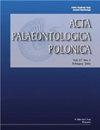美国俄克拉何马州Optima地方动物群中晚中新世哺乳动物的古生态学
IF 1.9
3区 地球科学
Q2 PALEONTOLOGY
引用次数: 0
摘要
Optima当地动物群代表了中新世晚期(Hemphillian)大草原和草原之间生态转变的重要一瞥,现在是北美大平原的中南部。虽然以马为主,但来自Optima的食草动物在形态上是多样的,适应了浏览和放牧的生活方式。同样,食肉动物也表现出相似的体型范围和饮食行为。在这项研究中,我们使用碳酸盐同位素、中磨损、牙齿断裂和磨损分析来研究俄克拉何马州自然历史博物馆收集的单一地点哺乳动物的饮食复杂性。共分析了17个类群,包括5个异趾目(希克远角兽、内插恐龙、欧利波新河马、ingenuus Nannippus和Astrohippus ansae)和4个偶蹄目(古埃及特oceros guymonensis、hemphilensis Pediomeryx、matthewmegatylopus和Platygonus sp .)。一种长鼻目动物(Mammut sp.),两种啮齿类动物(Dipoides indet.)。以及5种食肉动物(Agriotherium schneideri, amphimacharodus coloradensis, Borophagus secundus, Eucyon davisi, Pliotaxidea cf. nevadensis)。稳定同位素分析和牙齿中磨损均表明,在Optima食草动物中存在广泛的饮食分配,其中偶蹄动物被确定为混合摄食动物,而异蹄动物被恢复为食草动物。在食肉动物中,大型猫科动物amphimacharodus coloradensis是一种具有有限牙齿断裂和丰富δ 13c特征的超级食肉动物,表明其较低的胴体利用率和对马的猎物偏好。犬科动物的饮食更广泛,第二齿犬科动物通过更高的牙齿断裂率,显示出更大比例的尸体消耗。大型熊科动物Agriotherium schneideri在此被解释为杂食动物,基于耗尽的δ 13c值。总的来说,我们发现了俄克拉荷马州亨菲利亚晚期食肉动物和食草动物饮食生态位多样性的证据,这可能是由该地区草原扩张所驱动的。本文章由计算机程序翻译,如有差异,请以英文原文为准。
The paleoecology of the Late Miocene mammals
from the Optima Local Fauna of Oklahoma, USA
The Optima Local Fauna represents an important glimpse into the ecological transition between savannah and grassland during the late Miocene (Hemphillian) of what is now the southcentral Great Plains of North America. Though dominated by horses, herbivores from the Optima are morphologically diverse, bearing adaptations for both browsing and grazing lifestyles. Likewise, the carnivorans show similar ranges of size and presumed dietary behavior. In this study, we used carbonate isotope, mesowear, and tooth breakage and wear analyses to investigate the dietary complexity of mammals from a single site collected by the Oklahoma Museum of Natural History. Seventeen taxa were analyzed, including five perissodactyls ( Teleoceras hicksi, Dinohippus interpolatus, Neohipparion eurystyle, Nannippus ingenuus, and Astrohippus ansae ), four artiodactyls ( Texoceros guymonensis, Pediomeryx hemphillensis, Megatylopus matthewi, and Platygonus sp . ), a single proboscidean ( Mammut sp.), two rodents ( Dipoides indet. and Umbogaulus monodon ), and five carnivorans ( Agriotherium schneideri, Amphimachairodus coloradensis, Borophagus secundus, Eucyon davisi, Pliotaxidea cf. nevadensis ). Both stable isotope analysis and dental mesowear indicate a broad dietary partitioning occurred among the Optima herbivores, where the artiodactyls were identified as mixed feeders and the perissodactyls were recovered as grazers. In the carnivorans, the large felid Amphimachairodus coloradensis was a hypercarnivore with limited tooth breakage and an enriched δ 13 C signature, indicating low carcass utilization and a prey preference for horses. The canids had a more generalized diet, with B. secundus showing a greater proportional consumption of carcasses through a higher tooth breakage rate. The large ursid Agriotherium schneideri is here interpreted as an omnivore based on depleted δ 13 C values. Overall, we found evidence for a diversity of dietary niches in both carnivores and herbivores during the late Hemphillian in Oklahoma, likely driven by the expansion of grasslands in the region.
求助全文
通过发布文献求助,成功后即可免费获取论文全文。
去求助
来源期刊

Acta Palaeontologica Polonica
地学-古生物学
CiteScore
2.80
自引率
5.60%
发文量
36
审稿时长
12.5 months
期刊介绍:
Acta Palaeontologica Polonica is an international quarterly journal publishing papers of general interest from all areas of paleontology. Since its founding by Roman Kozłowski in 1956, various currents of modern paleontology have been represented in the contents of the journal, especially those rooted in biologically oriented paleontology, an area he helped establish.
In-depth studies of all kinds of fossils, of the mode of life of ancient organisms and structure of their skeletons are welcome, as those offering stratigraphically ordered evidence of evolution. Work on vertebrates and applications of fossil evidence to developmental studies, both ontogeny and astogeny of clonal organisms, have a long tradition in our journal. Evolution of the biosphere and its ecosystems, as inferred from geochemical evidence, has also been the focus of studies published in the journal.
 求助内容:
求助内容: 应助结果提醒方式:
应助结果提醒方式:


